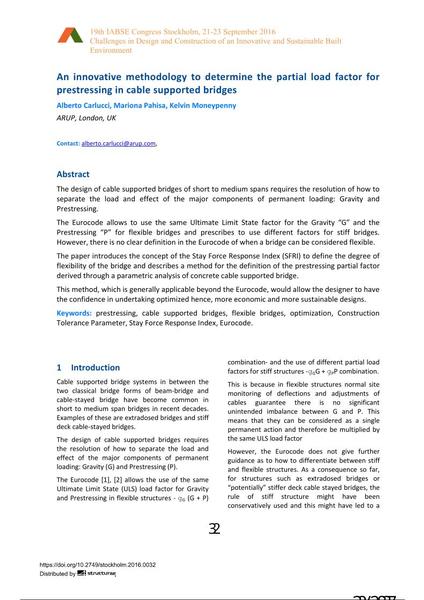An innovative methodology to determine the partial load factor for prestressing in cable supported bridges

|
|
|||||||||||
Détails bibliographiques
| Auteur(s): |
Alberto Carlucci
(ARUP, London, UK)
Mariona Pahisa (ARUP, London, UK) Kelvin Moneypenny (ARUP, London, UK) |
||||
|---|---|---|---|---|---|
| Médium: | papier de conférence | ||||
| Langue(s): | anglais | ||||
| Conférence: | IABSE Congress: Challenges in Design and Construction of an Innovative and Sustainable Built Environment, Stockholm, Sweden, 21-23 September 2016 | ||||
| Publié dans: | IABSE Congress Stockholm, 2016 | ||||
|
|||||
| Page(s): | 32-39 | ||||
| Nombre total de pages (du PDF): | 8 | ||||
| Année: | 2016 | ||||
| DOI: | 10.2749/stockholm.2016.0032 | ||||
| Abstrait: |
The design of cable supported bridges of short to medium spans requires the resolution of how to separate the load and effect of the major components of permanent loading: Gravity and Prestressing. The Eurocode allows to use the same Ultimate Limit State factor for the Gravity “G” and the Prestressing “P” for flexible bridges and prescribes to use different factors for stiff bridges. However, there is no clear definition in the Eurocode of when a bridge can be considered flexible. The paper introduces the concept of the Stay Force Response Index (SFRI) to define the degree of flexibility of the bridge and describes a method for the definition of the prestressing partial factor derived through a parametric analysis of concrete cable supported bridge. This method, which is generally applicable beyond the Eurocode, would allow the designer to have the confidence in undertaking optimized hence, more economic and more sustainable designs. |
||||
| Mots-clé: |
Eurocode
|
||||

